Intel Core i5-11400 vs AMD Ryzen 5 3600: Budget Gaming CPU Face-off
Which sub-$200 processor is best?
The Intel Core i5-11400 vs AMD Ryzen 5 3600 rivalry is a heated battle for budget gaming rig supremacy in the increasingly competitive desktop PC market. AMD's Ryzen 5000 processors took the lead in the desktop PC from Intel's competing Comet Lake processors last year, upsetting our Best CPU for gaming recommendations and our CPU Benchmarks hierarchy. But AMD's ascension to the top of the desktop PC market has found it focusing on high-end premium chips while it sticks with its older, Zen 2 chips for its lower-range lineup that caters to the majority of gamers (the $299 Ryzen 5 5600X is the bottom of the Zen 3 stack) . That's left Intel plenty of room to strike in the budget gaming arena with its Rocket Lake Core i5-11400.
Surprisingly, the Rocket Lake Core i5 squares off with the venerable Ryzen 5 3600, AMD's two-year-old silicon that comes armed with six cores and twelve threads powered by the last-gen Zen 2 architecture. This processor has served as the go-to recommendation for budget rigs for several years, largely on the strength of its wonderful blend of performance and pricing, but due to ongoing chip shortages, finding the Ryzen 5 3600 anywhere near its normal pricing of $199 is a rarity. It's also simply getting long in the tooth.
In contrast, Intel's Core i5-11400 comes with an ultra-competitive $157 to $182 price point and is available at most major retailers near its suggested price point. This chip comes with six cores, twelve threads, and Intel's new Cypress Cove architecture that brings about tremendous performance improvements in single-threaded and gaming performance. It even holds its own in threaded work, too.
We put the Core i5-11400 up against the Ryzen 5 3600 in a six-round faceoff to see which chip takes the crown in our gaming and application benchmarks, along with other key criteria like power consumption and pricing. Let's see how the chips stack up.
Features and Specifications of AMD Ryzen 5 3600 vs Intel Core i5-11400
| Header Cell - Column 0 | Suggested Price | Cores / Threads | Base (GHz) | Peak Boost (Dual/All Core) | TDP | Architecture | iGPU | L3 |
|---|---|---|---|---|---|---|---|---|
| AMD Ryzen 5 3600 | $199 (much higher at retail) | 6 / 12 | 3.6 | 4.2 | 65W | Zen 2 | None | 32MB |
| Intel Core i5-11400 (KF) | $182 - $157 (KF) | 6 / 12 | 2.6 | 4.4 (TB2) / 4.2 | 65W | Cypress Cove | UHD Graphics 730 Xe 24EU | 12MB |
At its launch in 2019, the 7nm Ryzen 5 3600 set a new bar for budget processors with six Zen 2 cores and twelve threads that operate at a 3.6 GHz base and 4.2 GHz boost frequency. After overclocking, the 65W Ryzen 5 3600 trades blows with its more expensive 95W 3600X counterpart, long making it one of the best deals on the market. Additionally, the chip drops into B450 and B550 platforms, making a great pairing for a chip in the ~$200 price class.
AMD refreshed the Ryzen 3000 lineup with the XT series last year, but those chips didn't deliver enough performance uplift (typically in the two to three percent range) to justify the higher price tag. The XT series also didn't include a refreshed Ryzen 5 3600 model. Instead, AMD stopped at the $250 3600XT, leaving the 3600 stranded in the $160 to $200 price class. The short-lived XT refresh generation was ultimately designed to boost AMD's retail pricing, but the consensus was to just stick with the existing Ryzen 3000 processors for the best value.
The new Ryzen 5000 series finally, and fully, eclipsed Intel in every performance metric, but it also came with the highest pricing we've seen yet from AMD. This series bottoms out at the Ryzen 5 5600X, a truly impressive chip that unfortunately also raised the bar for entry into the Ryzen ecosystem to $299. That means the Ryzen 5 3600 still shoulders the load for AMD's budget gaming chips, and ongoing shortages have seen pricing for this sought-after chip skyrocket to $240, and often more.
That's a void that Intel is all too happy to fill with its newest Rocket Lake chips. Intel's $182 Core i5-11400 also comes with six cores and twelve threads, but Team Blue's chips come with the new Cypress Cove architecture paired with the aging 14nm process. This chip operates with a 2.6-GHz base, 4.4 GHz Turbo Boost 2.0, and 4.2 GHz all-core clock rates, and the Cypress Cove cores deliver a 19% IPC uplift over the previous-gen Comet Lake cores.
The Core i5-11400 comes with the UHD Graphics 730 Xe engine with 24 EUs, so Intel did pare back the engine for its lower-end chips. AMD's competing Ryzen models come without integrated graphics. Additionally, if you plan to use a discrete GPU, you can opt for the $157 graphics-less Core i5-11400F to save some coin.
The Core i5-11400 comes with a bundled cooler, but it isn't sufficient for most enthusiasts, especially if they plan on tuning the chip by lifting the power limits. In contrast, the Ryzen 5 3600 comes with a bundled Wraith Stealth cooler that can more than handle the heat, though you would be best served on stepping up to a beefier model if you plan on overclocking.
Both the Core i5-11400 and Ryzen 5 3600 support PCIe 4.0, though it is noteworthy that Intel's chipset doesn't support the speedier interface. Instead, devices connected to Intel's chipset operate at PCIe 3.0 speeds. That means you'll only have support for one PCIe 4.0 m.2 SSD port on your motherboard, whereas AMD's chipset is fully enabled for PCIe 4.0, giving you more options for a plethora of faster devices.
Both chips also support two channels of DDR4-3200 memory, but Intel's new Gear memory feature takes a bit of the shine off Intel's memory support. The 11400 supports DDR4-2933 in Gear 1 mode at stock settings, which provides the best latency and performance for most tasks, like gaming. You'll have to operate the chip in Gear 2 mode for warrantied DDR4-3200 support, but that results in performance penalties in some latency-sensitive apps, like gaming, which you can read about here.
For some users, the 11400 does have an insurmountable advantage over the Ryzen 5 3600: The chip comes with the new UHD Graphics 730 armed with 24 EUs based on the Xe graphics engine, while the Ryzen 5 3600 comes without integrated graphics. That means Intel wins by default if you don't plan on using a discrete GPU.
Winner: Intel
The Core i5-11400 and Ryzen 5 3600 battle it out with six cores and twelve threads, but the Core i5-11400 takes the win due to its higher per-core performance that comes as a byproduct of the higher clock rates combined with the new Cypress Cove architecture.
Get Tom's Hardware's best news and in-depth reviews, straight to your inbox.
The Core i5-11400 comes with integrated graphics, so it wins by default if you don't plan on using a discrete GPU. Conversely, you can sacrifice the graphics for a lower price point. AMD's lower-end chips with integrated graphics are currently unavailable or sell at scalper pricing, but we hope that changes by the end of the year when the Ryzen 5000 Cezanne APUs arrive.
Gaming Performance on AMD Ryzen 5 3600 vs Core i5-11400
As per usual, we're testing with an Nvidia GeForce RTX 3090 to reduce GPU-imposed bottlenecks as much as possible. Differences between test subjects will shrink with lesser cards, which you'll often see with this class of chip, or higher resolutions. Below you can see the geometric mean of our gaming tests at 1080p and 1440p, with each resolution split into its own chart. PBO indicates an overclocked Ryzen configuration. You can find our test system details here.
Intel's Core i5-11400 comes with a generally unimpressive bundled cooler, so we tested with the stock cooler and with a more capable Corsair H115i 280mm water cooler to show the difference between the two types of cooling. Additionally, Rocket Lake brings memory overclocking to Intel's locked chips for the first time, so we ran tests in a quasi-overlocked configuration. Here's the decoder ring for the configurations listed in the chart:
- Core i5-11400 AIO No PL Mem OC: Tested with Corsair H115i 280mm water cooler, power limits removed, memory overclocked to DDR4-3600 in Gear 1 mode (Gear 2 results in performance regressions)
- Core i5-11400 AIO No PL: Tested with Corsair H115i 280mm water cooler, power limits removed, stock DDR4-2933 memory in Gear 1 mode (Gear 2 results in performance regressions)
- Core i5-11400 Stock Cooler: Tested with Stock cooler, power limits enforced, stock DDR4-2933 in Gear 1


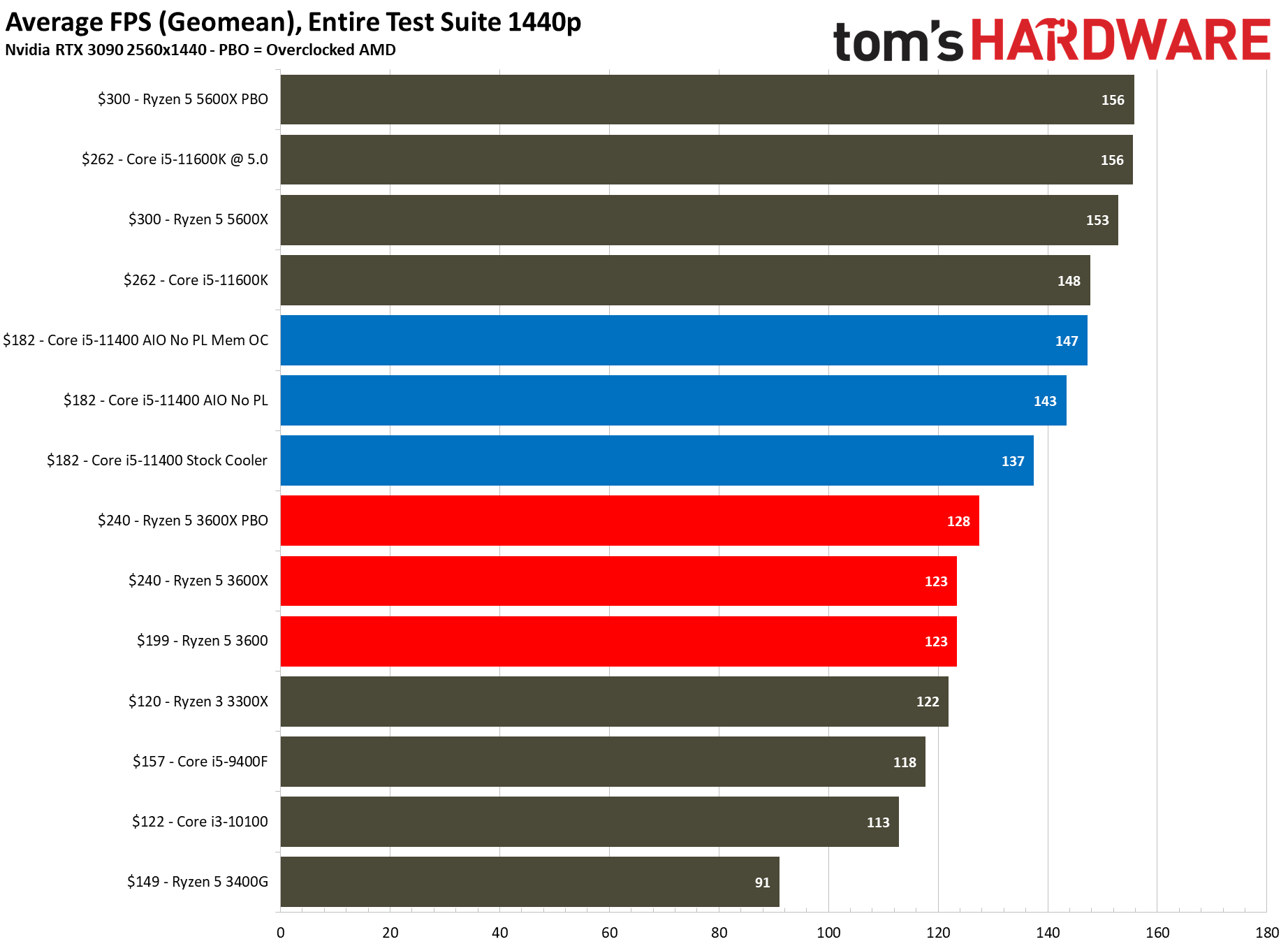

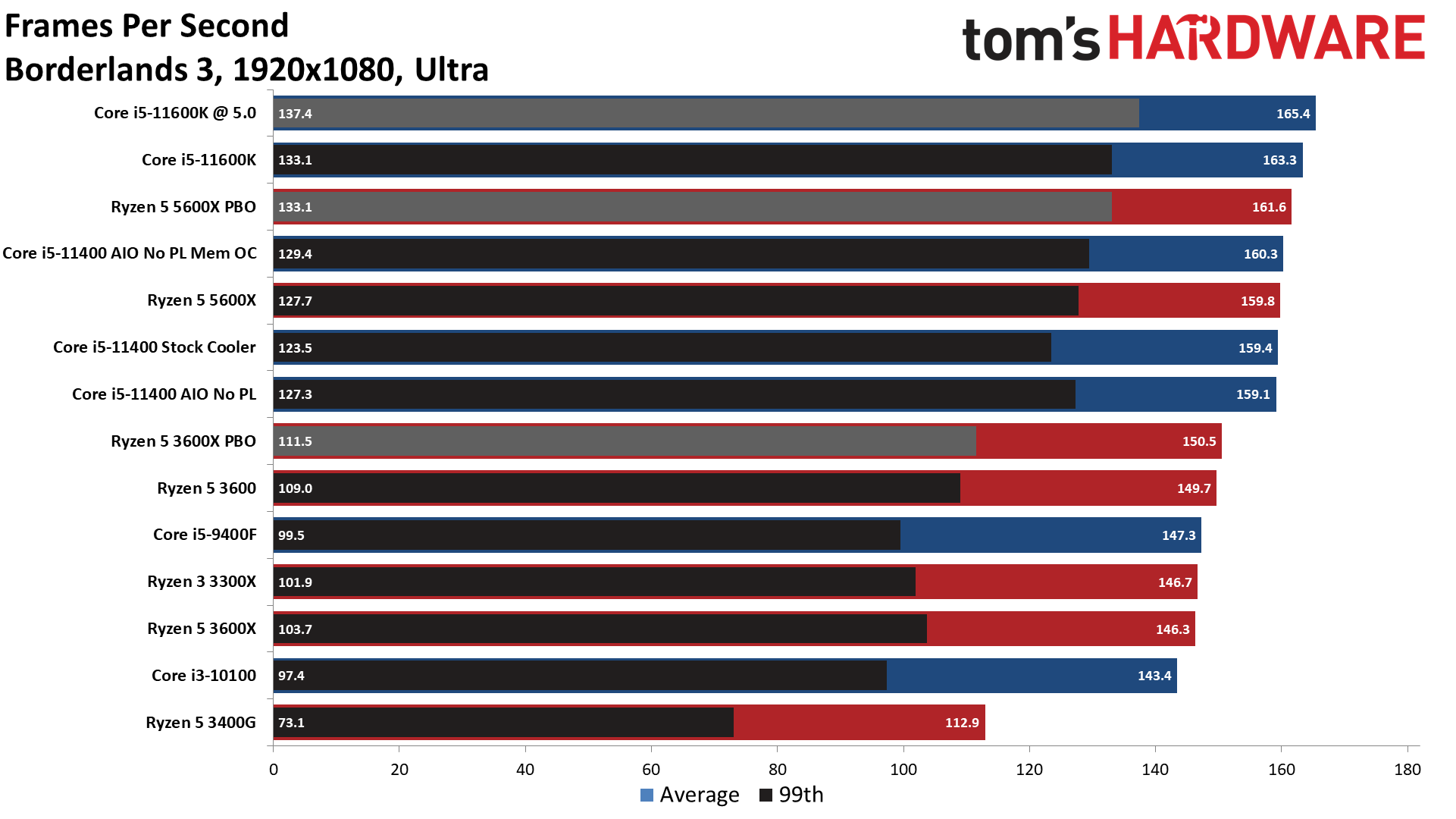



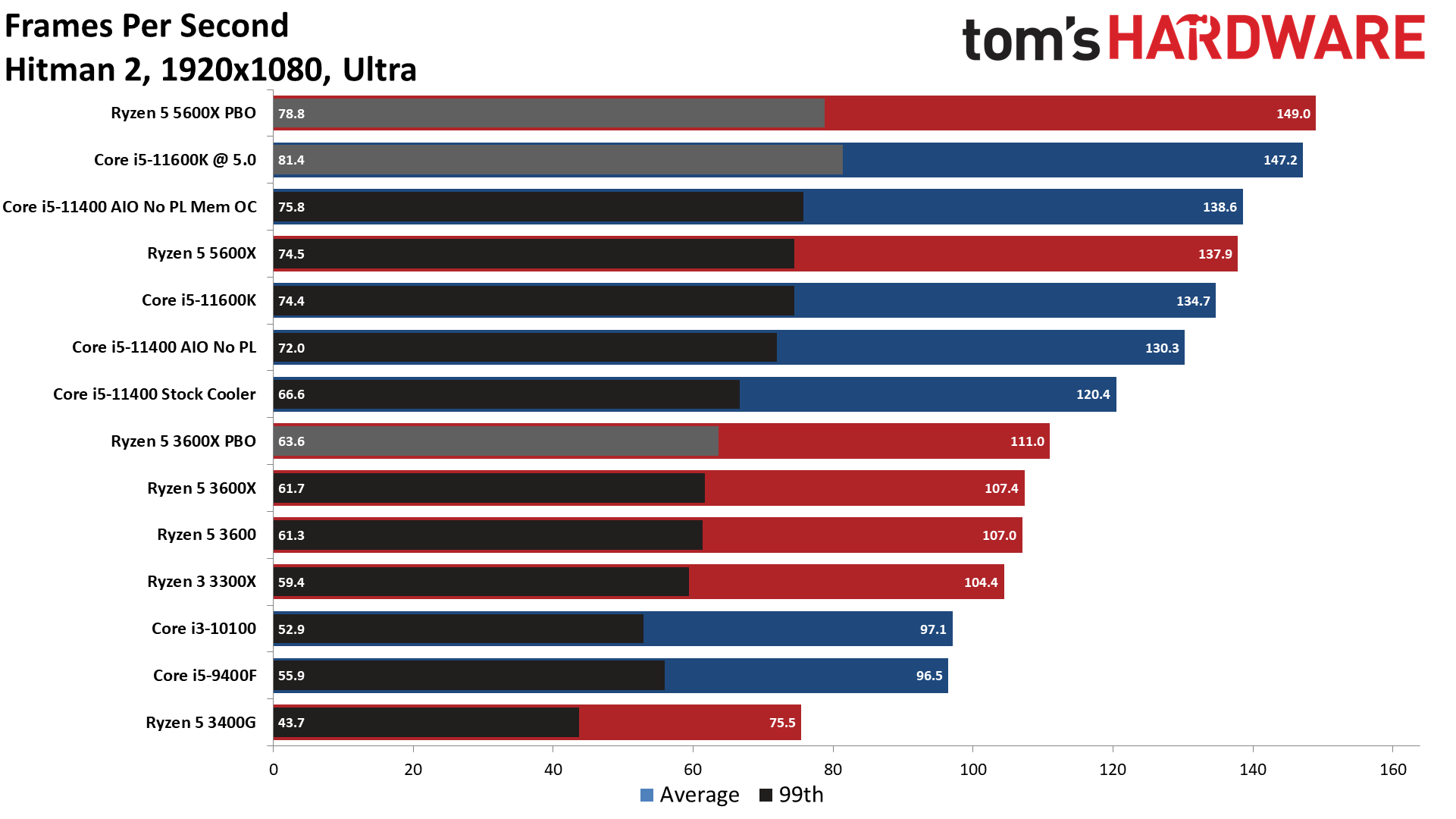


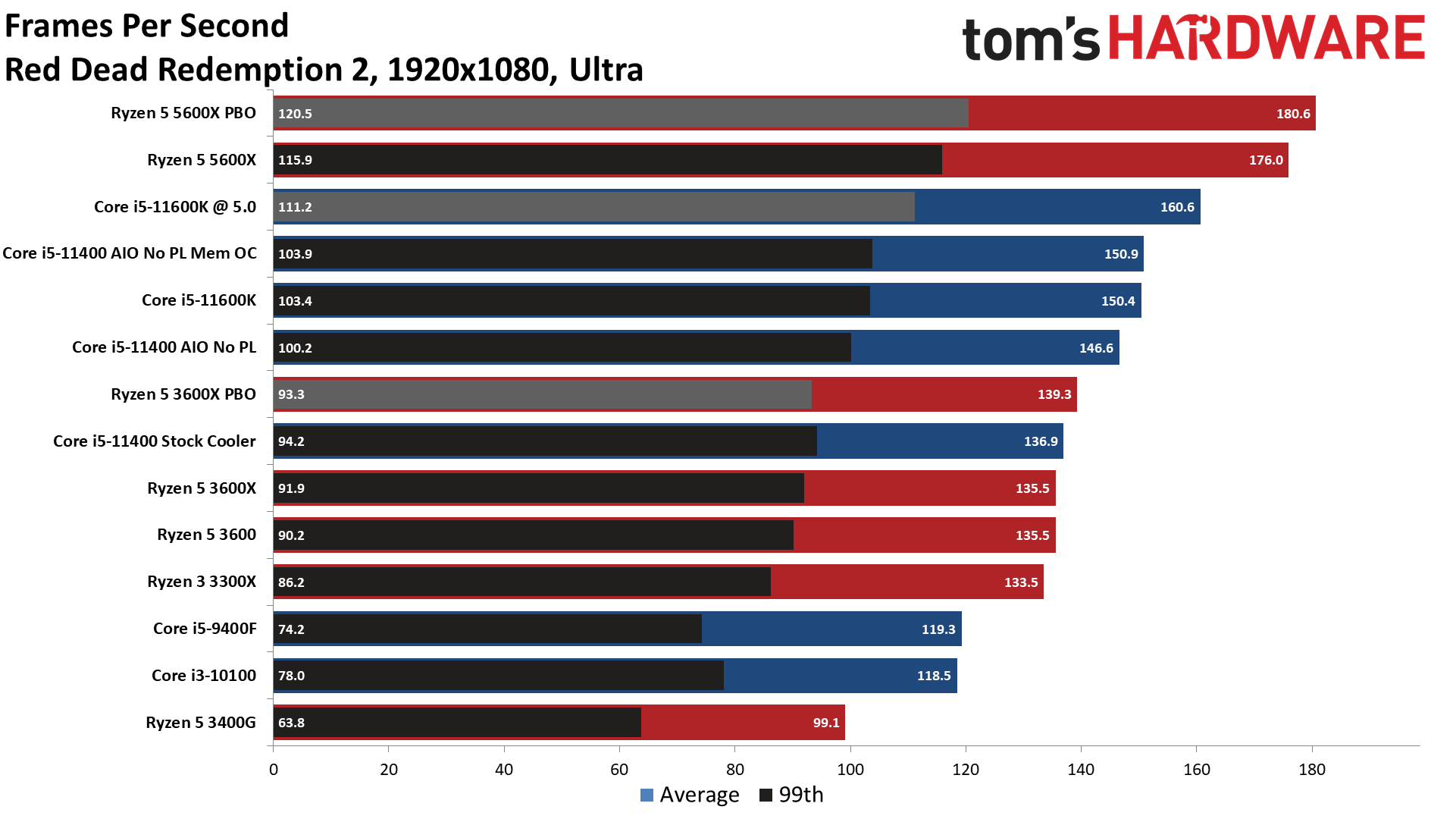






The $182 Core i5-11400 delivers a blowout victory over the Ryzen 5 3600 in gaming, which isn't too surprising given that we're looking at the much newer Willow Cove architecture battling it out with AMD's last-last-gen Zen 2 chip.
We use the pricier overclocked Ryzen 5 3600X chip as the stand-in for the overclocked Ryzen 5 3600 (these two chips are very similar after overclocking). Even running the Ryzen 5 3600X in the auto-overclocked Precision Boost Overdrive (PBO) configuration does little to even the score at 1080p — the Core i5-11400 in its slowest configuration with a stock cooler and power limits enforced is 8.4% faster than the overclocked Ryzen 5 3600X with a 280mm liquid cooler at 1080p, and 7% faster at 1440p.
Intel has finally enabled at least some overclocking potential with its locked chips — now you can tune the memory in addition to removing the power limits, both of which create a quasi-overclocked configuration that yields a nice performance bump. The Core i5-11400 with overclocked memory is 19.2% faster at 1080p than the overclocked Ryzen 5 3600 and 14.8% faster at 1440p.
Notably, the impact of overclocked memory on the 11400 can vary tremendously by title, with some games like Far Cry 5, Hitman 2, Project Cars 3, and Shadow of the Tomb Raider showing much better scaling than implied by the geometric mean that includes a few titles that don't respond well to memory overclocking.
Flipping through the individual games shows that the Core i5-11400 dominates the game benchmarks against the Ryzen 5 3600, with the latter's only win coming as an overclocked test run in the Red Dead Redemption 2 benchmark.
Winner: Intel
The Core i5-11400 is the uncontested gaming performance leader in its price range by a significant margin, much of which simply stems from the fact that AMD has neglected to update its entry-level chips for two years.
The Core i5-11400 wins by impressive deltas even with its stock cooler, but naturally, a better cooler unlocks more performance. The addition of memory overclocking is also an easy boost, especially considering that we only tuned the memory up to DDR4-3600 so we could stay in the low-latency Gear 1 mode. That means you won't have to drop an exorbitant amount of money on a higher-spec'd memory kit.
That said, this class of chip is often paired with lesser graphics cards, and most serious gamers play at higher resolutions. In both of those situations, the deltas between the chips will shrink. However, it's rational to expect that the Core i5-11400 will leave a bit more room to grow for future GPU upgrades.
Application Performance of Intel Core i5-11400 vs Ryzen 5 3600





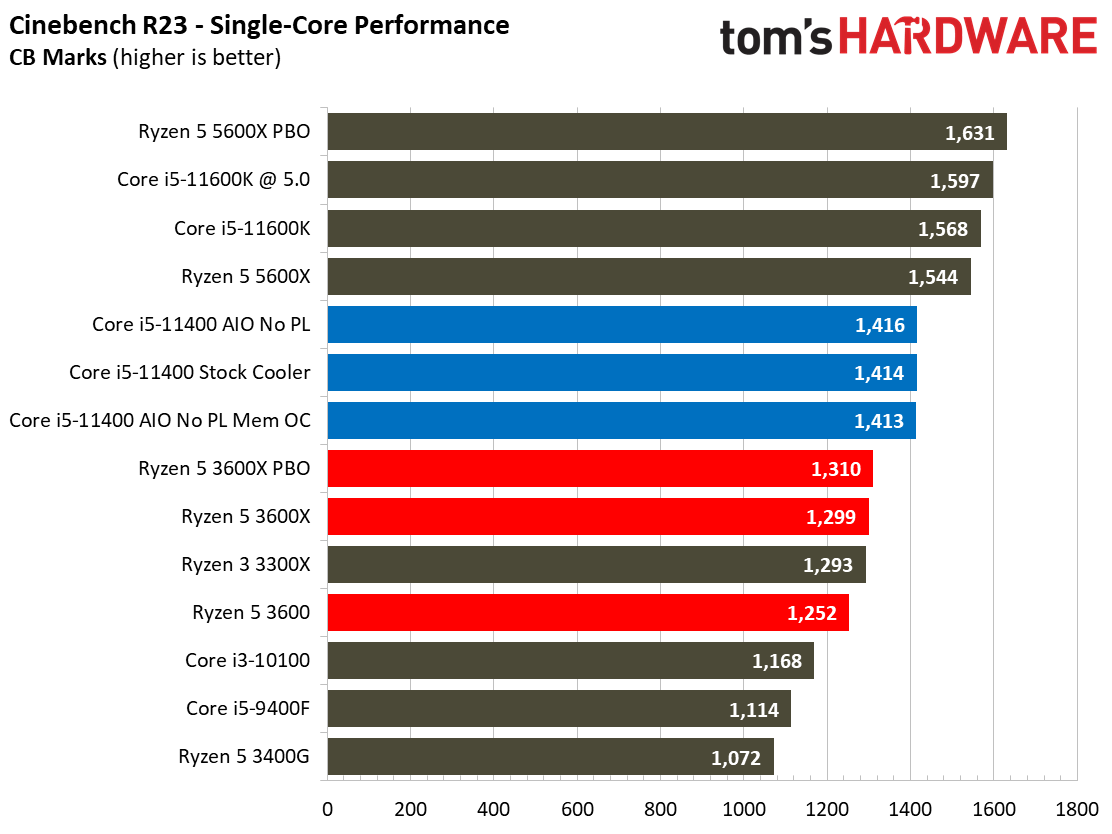



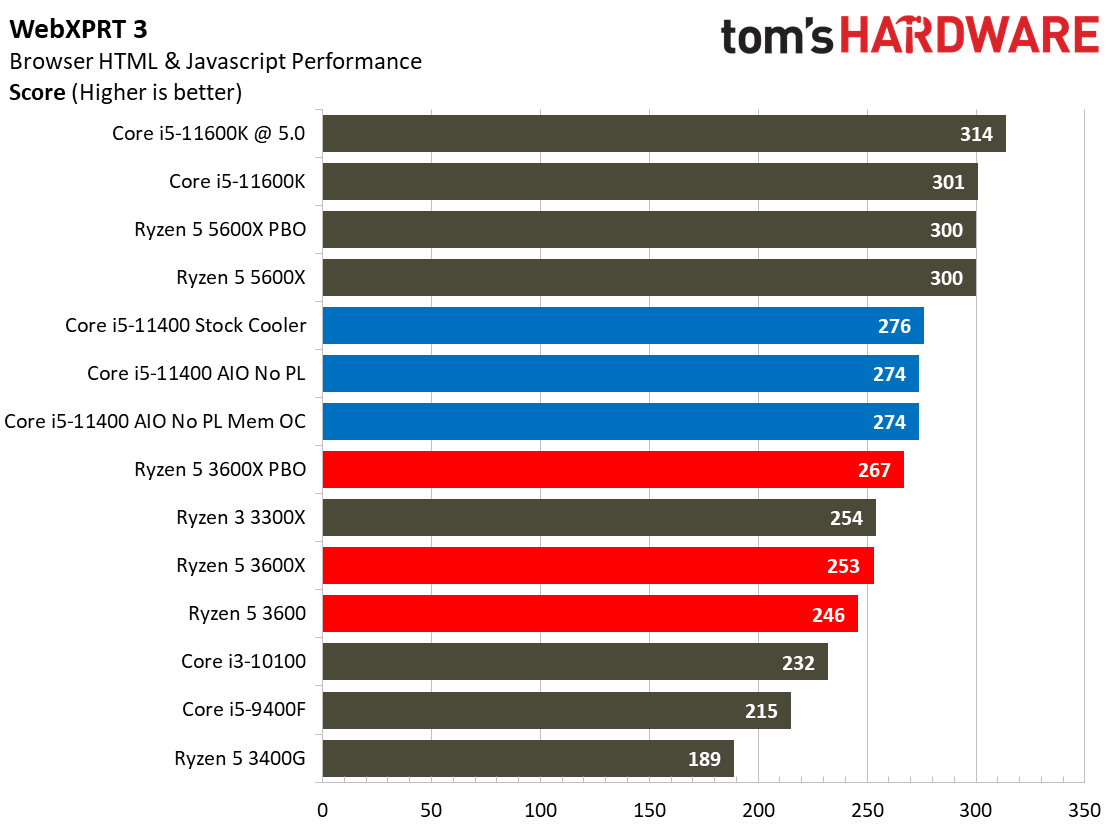

We can boil down productivity application performance into two broad categories: single- and multi-threaded. The first slide in the above album has a geometric mean of performance in several of our single-threaded tests. As with all cumulative measurements, use this as a general guide and be aware that performance will vary based on workload.
Intel's Cypress Cove architecture is a big step forward; here, we can see that the Core i5-11400 is ~13% faster than the competing Ryzen 5 3600 at stock settings and 9% faster after we overclock the Zen 2 silicon. The Core i5-11400 doesn't experience any uplift in single-threaded work from lifting the power limits, but it easily beats the comparably-priced Ryzen processors.
This type of pronounced performance advantage can't be understated, as large deltas like this are noticeable in latency-sensitive workloads, like web browsing, application start times, and the general feel of 'snappiness' from your system. You can see how that plays out in the full gamut of benchmarks in the album.



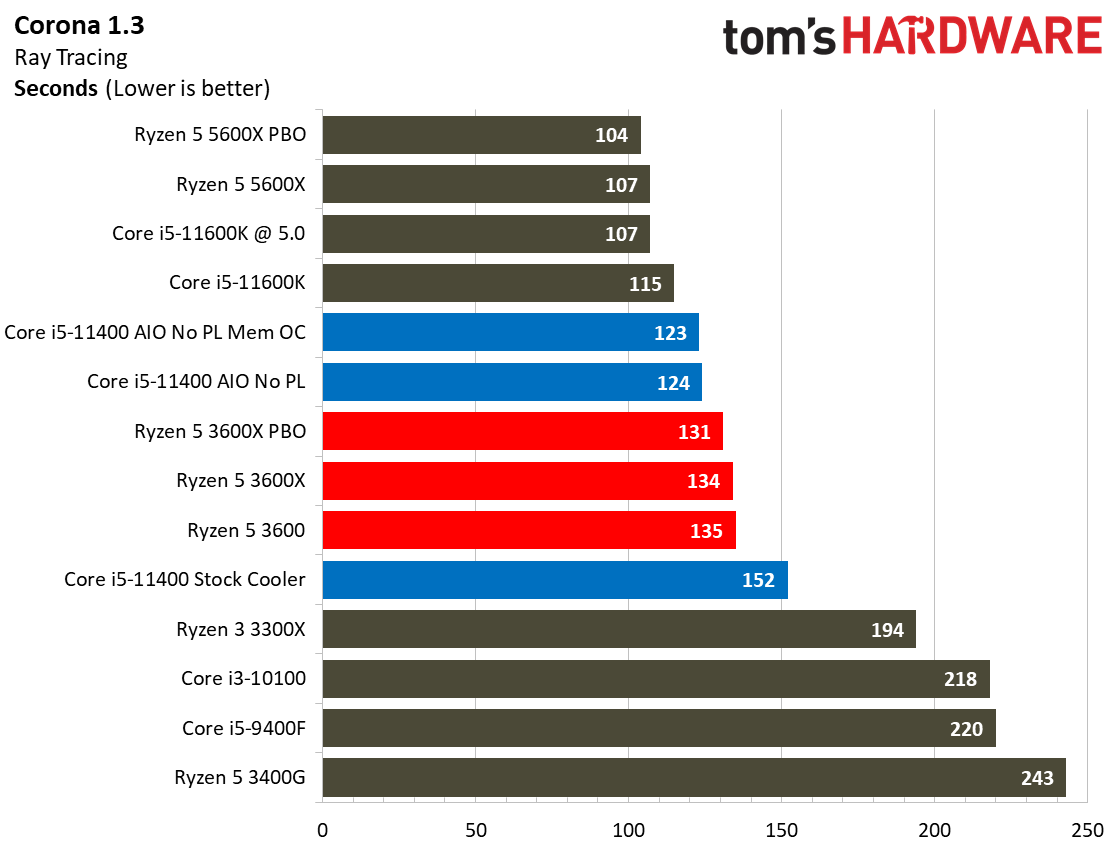







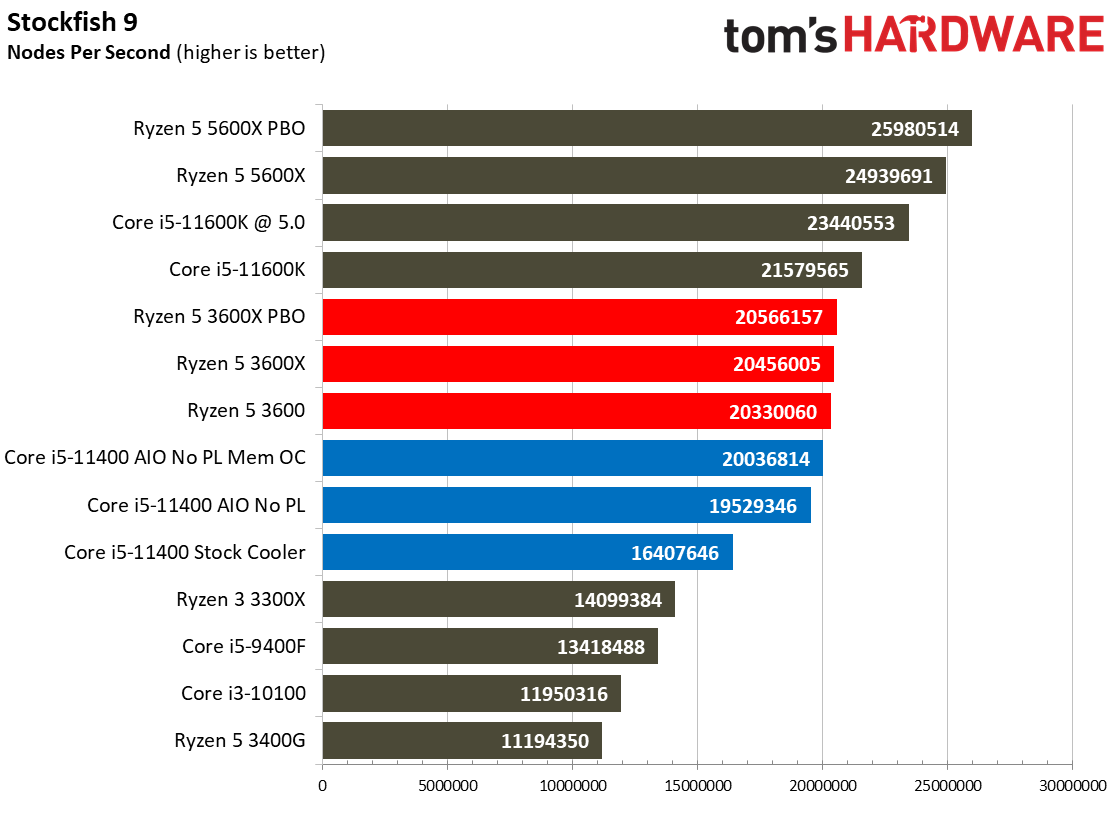
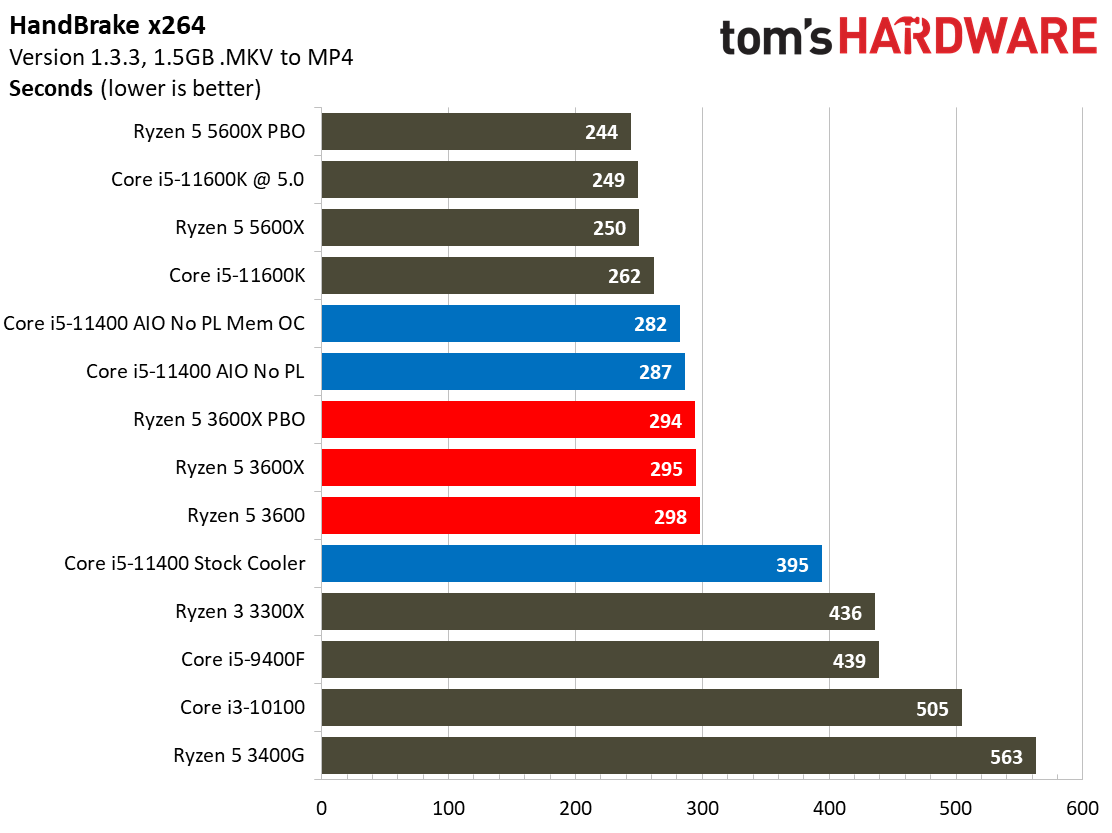









Here we take a closer look at performance in heavily-threaded applications, which has long been the stomping grounds of AMD's core-heavy Ryzen processors.
The Ryzen 3000 processors are still competitive in threaded work, which isn't too surprising because they have the same number of cores and threads as the 11400. The Ryzen 5 3600 is 12.7% faster in our cumulative measurement if you top the Core i5-11400 with the stock cooler and force it to strictly adhere to Intel's recommended power settings. However, removing the Core i5-11400's power limits gives it a ~14% lead over the stock Ryzen 5 3600 and an ~11% lead over the overclocked 3600X.
Winner: Intel
The Core i5-11400 vs Ryzen 5 3600 battle is incredibly lopsided in single-threaded applications — here, the 11400 pulls out an uncontested win. The 11400 trails in threaded work if you use the stock cooler, but upgrading to just about any cooler improves the situation (yeah, Intel's stock cooler is that bad). Topping the Core i5-11400 with a sufficient cooler yields leading performance in threaded applications.
Overall, the Core i5-11400 has a better mix of performance in our test suite, and that's complicated by the fact that the Ryzen 5 3600 sells at a much higher price point, as we'll cover below.
Overclocking Ryzen 5 3600 vs Core i5-11400
We have reached the land of diminishing returns for overclocking the highest-end chips from both AMD and Intel, largely because both companies are engaged in a heated dogfight for performance superiority. As a result, much of the overclocking frequency headroom is rolled into standard stock performance, leaving little room for tuners, making memory and fabric overclocking all the more important. However, there are still plenty of advantages to overclocking/tuning the midrange models, which impacts our Ryzen 5 3600 vs Core i5-11400 battle. Just be aware that your mileage may vary.
Intel has long restricted overclocking to its pricey K-series models, while AMD freely allows overclocking with all SKUs on almost any platform, earning plenty of cachet with enthusiasts. However, we see signs of some improvement here from Intel, as it has now enabled memory overclocking on its B560 and H570 chipsets across the board. That means that you can now overclock the memory on Intel's locked chips, like the Core i5-11400. That said, Intel's new paradigm of Gear 1 and Gear 2 modes does reduce the value of memory overclocking, which you can read more about here.
As before, you can lift Intel's recommended power limits to get a sort of quasi-overclock, but while remaining in warranty. As we've shown above, that gives performance a nice kick, especially when paired with overclocked memory. However, this technique still falls far short of fully unlocked multipliers that allow you to boost clock rates, and it doesn't look like Intel will unlock its full lineup any time soon.
AMD's Ryzen 5 3600 comes with innovative boost technology that largely consumes most of the available frequency headroom, so there is precious little room for bleeding-edge all-core overclocks. In fact, all-core overclocking with AMD's chips is lackluster; you're often better off using its auto-overclocking Precision Boost Overdrive 2 (PBO2) feature that boosts multi-threaded performance. AMD also has plenty of Curve Optimization features that leverage undervolting to increase boost activity. However, as we can see in our performance results, there is still some room on the table for additional performance via automated overclocking for the Ryzen processors.
Winner: AMD
There's still plenty of room to boost performance via overclocking in the budget end of the gaming PC spectrum, and Intel's new move to allow memory overclocking with locked chips on its latest motherboards is encouraging. However, even though you can gain quite a bit of extra performance, Intel's segmentation still prevents us from fully tweaking the processor via multiplier-based frequency overclocking.
In contrast, AMD's Ryzen 5 3600 is fully overclockable on nearly every platform (except A-series), giving it the win in this category. The company's auto-overclocking PBO feature is also another notable advantage.
Power Consumption, Efficiency, and Cooling of Intel Core i5-11400 vs AMD Ryzen 5 3600












AMD's Ryzen 5 3600 might be two years old, but the 7nm process is still more power-efficient than the 14nm found on Intel's Core i5-11400. Intel has also turned up the power dial on its Rocket Lake processors yet again to remain competitive, so you'll generally have to ignore the higher power consumption if you choose to go with an 11th-gen Intel processor.
The Core i5-11400 does fall into a lower 65W PL1 (base frequency-TDP) and 154W PL2 (power during boost) envelope than its higher-performance counterparts, though, which takes some of the sting out of Intel's adjustments.
Power consumption and heat go hand in hand, so you'll have to accommodate that power consumption with a robust cooler. The Core i5-11400 does suffer from reduced performance with the stock cooler, but you can get away with far less than the 280mm liquid cooler we used to showcase fully unconstrained performance.
We logged up a peak of 161W of power consumption with the 11400 during our benchmarks, but that was with the power limits fully removed and the memory overclocked. In contrast, the Ryzen 5 3600X that stands in as our overclocked 3600 measured an 82W peak. Naturally, both chips will adhere strictly to their 65W power limit if those restrictions are enforced in the BIOS.
A quick look at the renders-per-day charts reveals that AMD's Ryzen processors are in another league in terms of power efficiency — you get far more performance per watt consumed, which results in lower power consumption and heat generation. The 3600's refined power consumption comes via TSMC's 7nm process, while Intel's 14nm process has obviously reached the end of the road in terms of absolute performance and efficiency.
Winner: AMD
AMD wins this round easily with lower power consumption, higher efficiency, and less thermal output. Intel has turned the power up to the extreme to stay competitive with AMD's 7nm Ryzen 5000 chips, and as a result, the Core i5-11400 pulls more power and generates more heat than the Ryzen 5 3600.
The Core i5-11400 comes with a bundled cooler, but you'll need to plan for a better cooler if you want to experience the best performance possible. In contrast, the Ryzen 5 3600 comes with a bundled cooler that is sufficient for full operation.
Pricing and Value of AMD Ryzen 5 3600 vs Intel Core i5-11400
The Ryzen 5 3600 has long been the value champion, but the supply of this chip is volatile as of the time of writing, to put it lightly, leading to price gouging. This high pricing comes as a byproduct of a combination of unprecedented demand and pandemic-spurred supply chain issues. Still, it certainly destroys the value proposition of the Ryzen 5 3600, especially given that it trails in several facets of performance. (Be aware that the pricing and availability of these chips can change drastically in very short periods of time, and they go in and out of stock frequently, reducing the accuracy of many price tracking tools.)
The Ryzen 5 3600 currently retails for $245 at Amazon through a third-party seller, and that's the only outlet with the chip in stock. The Ryzen 5 3600 had a $200 MSRP at launch, but it has routinely sold for far less, even bottoming out at just $160 last year. We're sure AMD is prioritizing its higher-margin parts, like the Ryzen 5000 series, so this high pricing is actually to be expected during the shortage, but it's still discouraging.
Meanwhile, the Core i5-11400 is in stock at multiple retailers either at or near its $183 MSRP. The Core i5-11400F is the value chip right now, but it is becoming harder to find. This chip carries a $153 MSRP, but we found it at a few retailers for ~$175. This chip recently bottomed out at $165 at Newegg, but that retailer no longer has stock.
Here's the breakdown (naturally, this will vary):
| Header Cell - Column 0 | Suggested Price | Current (volatile for 3600) | Price Per Core |
|---|---|---|---|
| Core i5-11400 | $183 | $183 to $190 | ~$30 |
| Ryzen 5 3600 | $200 | $245 (in stock at one outlet) | ~$40 |
| Core i5-11400F | $153 | $175 (spotty availability) | ~$29 |
Winner: Intel
Even at recommended pricing for both chips, Intel's aggressive pricing makes the Core i5-11400 a winner. However, the company also wins this stage of the battle convincingly based on an almost insurmountable advantage: You can actually find the 11400 readily available at retail for close to its suggested tray pricing. With much cheaper pricing both on a per-core and absolute basis, not to mention its performance advantages, the Core i5-11400 is the better buy.
The Core i5-11400F is plenty attractive if you don't need integrated graphics, but its current $175 price tag takes some of the shine off the loss of the iGPU. For another eight bucks, you can get the full-featured chip. However, pricing is dynamic, so we could see that come down soon.
AMD's decision to prioritize its high-margin Ryzen 5000 chips instead of releasing a new Zen 3 challenger in this price bracket has left a gaping hole in its product stack that Intel is all too happy to exploit. Given the state of the shortages, we don't expect the Ryzen 5 3600 pricing to improve any time soon. In either case, it would need to be priced significantly lower than the Core i5-11400 to make any sense.
Bottom Line
| Header Cell - Column 0 | Intel Core i5-11400 | AMD Ryzen 5 3600 |
|---|---|---|
| Features and Specifications | X | Row 0 - Cell 2 |
| Gaming | X | Row 1 - Cell 2 |
| Application Performance | X | Row 2 - Cell 2 |
| Overclocking | Row 3 - Cell 1 | X |
| Power Consumption, Efficiency, and Cooling | Row 4 - Cell 1 | X |
| Pricing and Value Proposition | X | Row 5 - Cell 2 |
| Total | 5 | 2 |
Here's the tale of the tape: Intel wins the Core i5-11400 vs Ryzen 5 3600 battle convincingly with a five to two advantage. It is surprising to see AMD so unprepared in the face of Intel's lower-priced chips, but the company's premium pricing has nullified Zen 3's impact on the entry-level gaming market, leaving Intel an opening that it is all too happy to exploit.
As a whole, the Core i5-11400 is the uncontested budget gaming rig champion. The 11400 is plenty adept in our full gamut of application tests, particularly in single-threaded performance. It also serves up plenty of threaded horsepower, particularly if you top it with a more capable cooler. With a better cooler, the 11400 matches the Ryzen 5 3600 even with the power limits strictly enforced. Removing the power limits gives it the uncontested lead in threaded work.
Intel even throws in memory overclocking, a first, if you use a B560 or H570 chipset (or Z-series, as usual). As you can see in our results, that boosts performance in many games and applications, but for a minimum of effort.
Remember that the effective range of the Gear 1 mode only stretches to ~DDR4-3800, so don't waste cash on an expensive kit. Pairing tuned memory with uncorked power limits is the closest you'll get to overclocking with the 11400, as it comes with its core frequency multipliers locked. That doesn't matter too much, though, as an 11400 at stock settings outperforms an overclocked Ryzen 5 3600.
You can currently find previous-gen Comet Lake chips, like the Core i5-10400, at really great pricing, but we think you'll enjoy the higher single-threaded performance and support for the PCIe 4.0 interface that comes with the Rocket Lake Core i5-11400. It will certainly give you more performance headroom for future upgrades, too.
AMD simply doesn't have a suitable chip in this price range to contend with the Core i5-11400. The Ryzen 5 3600 suffers from a severe shortage, and thus higher pricing, while the Core i5-11400 is widely available. Even at its suggested $200 MSRP, or even well below that mark, the Ryzen 5 3600 isn't a real contender against the Core i5-11400 due to its now-aging Zen 2 architecture.
For now, the Core i5-11400 takes the crown for the sub-$200 gaming CPU market in largely uncontested fashion, and given the current state of the chip shortages, we don't think that will change very soon. There are rumblings of a Ryzen XT-like refresh cycle coming soon, but it doesn't appear to include a new lower-tier chip to address the Core i5-11400, meaning it will likely continue to reign uncontested for the remainder of the year.
| Intel Socket 1200 (Z590) | Core i9-11900K, Core i5-11600K, Core i5-10600K, Core i5-11400, Core i3-10100 |
| Row 1 - Cell 0 | ASUS Maximus XIII Hero |
| Row 2 - Cell 0 | 2x 8GB Trident Z Royal DDR4-3600 - 10th-Gen: Stock: DDR4-2933, OC: DDR4-4000, 11th-Gen varies, outlined above |
| AMD Socket AM4 (X570) | AMD Ryzen 5 5600X, 3600X, 3600. 3300X, 3400G |
| MSI MEG X570 Godlike | |
| Row 5 - Cell 0 | 2x 8GB Trident Z Royal DDR4-3600 - Stock: DDR4-3200, OC: DDR4-4000, DDR4-3600 |
| All Systems | Gigabyte GeForce RTX 3090 Eagle - Gaming and ProViz applications |
| Row 7 - Cell 0 | Nvidia GeForce RTX 2080 Ti FE - Application tests |
| 2TB Intel DC4510 SSD | |
| EVGA Supernova 1600 T2, 1600W | |
| Row 10 - Cell 0 | Open Benchtable |
| Windows 10 Pro version 2004 (build 19041.450) | |
| Cooling | Corsair H115i, Custom loop |

Paul Alcorn is the Editor-in-Chief for Tom's Hardware US. He also writes news and reviews on CPUs, storage, and enterprise hardware.
-
Eximo Incorrectly lists the 11400 as having Intel HD 750, it has the HD 730.Reply
"The Core i5-11400 comes with the UHD Graphics 750 Xe engine with 24 EUs"
750 has 32 EUs
730 has 24 EUs -
VforV This article misses the mark so much it's painful... someone really wants to give intel at least 1 lousy win.Reply
I have a 3600 OC to 4.4Ghz all core running like a champ at 1.27v, which makes it faster, cooler, quieter and lower power consumption than a 3600X with PBO or 3700X with PBO (in games).
In terms of performance is very very close to the tuned 11400 you have here, with my DDR4 3600 CL16 ram kit I have.
Latest Zen 2 chips are great at OC-ing, much better than the first batches. Some can do 4.5GHz at the same voltage as mine, and I not talking about the XT versions either, but regular non X ones.
I also got it for 150 euros. That plus the MSI B450M Mortar Max which I got for 100 euro, makes it a better deal than any intel Failure Lake CPU can make.
Not to mention I still have an GREAT upgrade path, compared to the intel chip. -
-Fran- The motherboard selection for this comparison is iffy at best. The tests need a proper "budget" components round up.Reply
Much as I've said all the time and many agree: you won't pair a cheap CPU with a high end CLC-AIO or cooling solution or even motherboard (unless you plan on getting a K part down the line?). Most budget builds will stick to bottom of the barrel motherboards, which Intel is known for having really bad VRMs (Hardware Unboxed made a very good investigation on the subject), so the "just run it with MCE!" falls flat on its face for cheaper motherboards.
Yes, the CPU as a stand-alone component in isolation, looks great on paper, but in the bigger picture... Iffy.
Cheers! -
salgado18 Reply
You just proved the point that AMD won the overclocking round, and that's all.VforV said:This article misses the mark so much it's painful... someone really wants to give intel at least 1 lousy win.
I have a 3600 OC to 4.4Ghz all core running like a champ at 1.27v, which makes it faster, cooler, quieter and lower power consumption than a 3600X with PBO or 3700X with PBO (in games).
In terms of performance is very very close to the tuned 11400 you have here, with my DDR4 3600 CL16 ram kit I have.
Latest Zen 2 chips are great at OC-ing, much better than the first batches. Some can do 4.5GHz at the same voltage as mine, and I not talking about the XT versions either, but regular non X ones.
I also got it for 150 euros. That plus the MSI B450M Mortar Max which I got for 100 euro, makes it a better deal than any intel Failure Lake CPU can make.
Not to mention I still have an GREAT upgrade path, compared to the intel chip.
And you got a sale on that cpu. It can't count in a normal comparison, which works with MSRP.
Fully agree on the upgrade path: with a good motherboard, you can jump from a cheap 3600 all the way to a 5950x monster, and Intel can't do that. They should have a category for upgradeability there.
Otherwise, sorry, the i5 won this round. -
sosofm In my country 11400 is equal or higher price than 3600. The buyers loose money with 11400 in time, because the diference is almost nothing and the power consumption is double +you need a better Cpu cooler to keep 11400 at some reasonable temperatures.Reply -
larkspur With the stock cooler and power limits enforced the i5-11400 beats the more expensive OCed 3600x in the gaming suite. And with those power limits enforced it is very similar on power consumption. 65w will be fine for any compatible mobo - even the "bottom of the barrel" models.Reply
If I was building a budget gamer then I would seriously consider the i5-11400/11400f paired with a ~$30 cooler and a ~$120 B560 mobo. While the upgrade path isn't spectacular, this would make a nice, cheap gaming machine for the next few years while we wait for DDR5 to mature (assuming you can get a decent GPU!). If AMD had a budget Zen 3 chip then I'd certainly go with that, but the gaming-performance-value comparison here with Zen 2 clearly favors the i5-11400. -
InvalidError ReplyThe Core i5-11400 is the uncontested gaming performance leader in its price range by a significant margin, much of which simply stems from the fact that AMD has neglected to update its entry-level chips for two years.
AMD hasn't "neglected" to update its entry-level, it simply decided to jack it up by $100.
As for why the Zen 2 parts can be difficult to find, I strongly suspect this is simply AMD reducing its Zen 2 wafer orders to the bare minimum necessary to meet contract obligations so it can reallocate every wafer it can trim from obsolete parts elsewhere such as PS5, XB-XS, Zen 3 and Navi 2x - got to catch up with those back-orders. -
-Fran- Reply
The biggest problem with the 11400/F at 65W is they have no room to account for the lack of grunt in future tasks and games that do need MT. Just look at how bad it is for workloads that go over 4 hard cores. What about the temperatures? A $30 cooler puts the 11400/F siblings right next to the 3600 (well, if you're lucky to find it at $200; which is fair to account for the higher price in reality) that can do just fine (and then some more) with the stock/bundled cooler. Even more when the types of GPUs you'll pair with them are going to be in the 1650/5500XT territory?larkspur said:With the stock cooler and power limits enforced the i5-11400 beats the more expensive OCed 3600x in the gaming suite. And with those power limits enforced it is very similar on power consumption. 65w will be fine for any compatible mobo - even the "bottom of the barrel" models.
If I was building a budget gamer then I would seriously consider the i5-11400/11400f paired with a ~$30 cooler and a ~$120 B560 mobo. While the upgrade path isn't spectacular, this would make a nice, cheap gaming machine for the next few years while we wait for DDR5 to mature (assuming you can get a decent GPU!). If AMD had a budget Zen 3 chip then I'd certainly go with that, but the gaming-performance-value comparison here with Zen 2 clearly favors the i5-11400.
And then there's the platform. Bottom of the barrel motherboards are really garbage. Feature-wise and power-wise, they're just horrible. Again, Hardware Unboxed did a nice video about some, which weren't even the bottom of the barrel, as they didn't test H410's and I don't think there's an H510? AMD still has the A520 and reasonably fetured cheap B550's which still offer almost the same feature set as their higher tier siblings in most brands.
The 11400/F siblings are not bad CPUs, but I strongly believe they have to go down a bit more to be really, hands down, the best CPU you can recommend for true budget builds. It has too many caveats for my liking so unsavvy buyers won't trully get the best bang for their buck out of it. Case in point: OEM systems like your Dell and other SI's.
Cheers! -
jgraham11 This article completely missed the default configuration for the Intel 11400. With the ASUS Maximus XIII Hero they tested with, the default is that the CPU has its power limits off and if an inexperienced user (one who would buy an entry level CPU) used it with the stock cooler, they would get a situation where they have constant thermal throttling and it would cause the CPU to fail prematurely. Tom's: why are you not pointing out the default configuration as being dangerous and reckless with your CPU. Instead you throw on a liquid cooler and just disregard that point.Reply
Also, there are so many comments about how newer Zen 2 chips clock higher, that may be something to test out.